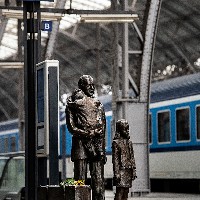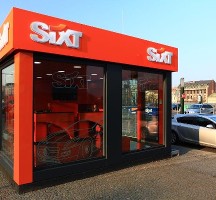Breadcrumbs navigation
Prague Main Railway Station (Praha hlavní nádraží)
The largest passenger railway station in the Czech Republic and the most important railway station in Prague. The historic building and the hall above the railway yard are among the most significant Art Nouveau monuments in the Czech Republic. A plethora of shops and food establishments will make waiting for your connection more pleasant. Occasional themed exhibitions are held in the check-in hall.
- Monuments & Architecture
- airport/train, bus stations
- Art Nouveau
Opening hours
Passenger areas are open:
Mon – Sun 3:30 - 01:15
Practical information
The railway station is located in the city center near Wenceslas Square on the border of three city districts (New Town, Vinohrady, and Žižkov). It is directly accessible from metro line C - Hlavní nádraží station and tram: 5, 9, 15, 26.
Airport Express (AE) buses provide direct connections to Václav Havel Prague Airport. Buses have an extended space for large luggage and stop right in front of the railway station building. Travel time is about 30 minutes.
Services at the station:
- domestic and international cash desks
- waiting room (daily 6:00-22:30)
- barrier-free toilets, showers
- restaurant, buffet, fast food restaurants
- exchange office, cash machine
- taxi rank
- luggage storage, bicycle storage
- other shops and services
Information on Czech Railways train connections and services (nonstop operation)
- tel. +420 221 111 122
- Search for Czech Railways connections
Contacts
- Prague Main Railway Station (Praha hlavní nádraží)
- Wilsonova 8
- 120 00 Praha 2 – Vinohrady
- +420221111122
Object history
The original railway station, which bore the name of Emperor Franz Josef, was built based on a design by Vojtěch Ignác Ullmann and Antonín Barviti in the Neo-Renaissance style in 1871. The building with two clock towers was 150 m long. Ionic columns supported the roofs of the porticos terminating both wings, and a spacious hall covered with a coffered ceiling occupied the ground floor of the station building. However, the building, which soon became known as the “chateau station” for its appearance, soon ceased to suffice capacity-wise. At the turn of the century, a public tender for a complete reconstruction was announced.
Architect Josef Fanta won the competition with a project that envisioned the entrance hall based on the principles of Art Nouveau style as a semicircular central pavilion with cash desks and entrances to the platform (today the space serves as a café). The entrance façade from the street comprises a large window in the shape of an arch. From the central section, two wings end with three-story buildings. The complex was enhanced with four towers: two that complete the edges of the central vestibule with peaks formed by glass globes. The other two adorn the wing buildings, each with a clock, and the south tower also features the symbol of the railways - a winged wheel. The station was rebuilt while remaining in full operation from 1901 to 1909. The dome above the central part of the building is decorated with Art Nouveau motifs and statues by Stanislav Sucharda and Ladislav Šaloun depicting Czech cities.
From 1972 to 1977, the building was extensively modernized, and a new check-in hall was added, which connects the historical building, the tracks, the roof car park and the Hlavní nádraží metro station.
Another complete reconstruction took place from 2006 to 2017 by the Italian company Grandi Stazioni, which modernized, among other things, the underground check-in hall, the central part of the historical Art Nouveau building and the glazing of the historical hall above the platforms. The underground hall is now divided into two floors where you’ll find shops, restaurants, and fast food outlets, ticket offices, waiting rooms and other station services associated with comfortable travel.
On platform 1 of the Main Railway Station is a monument commemorating Sir Nicholas Winton. In 1939, he saved 669 mostly Jewish children from the occupied territory of Czechoslovakia from being transported to concentration camps by arranging for them to leave by train to Great Britain. Sculptor Flor Kent is the artist behind the sculpture of the then thirty-year-old Winton with two of the children. It was ceremonially unveiled on September 1, 2009.
Information source: www.ceskedrahy.cz; Prague City Tourism










